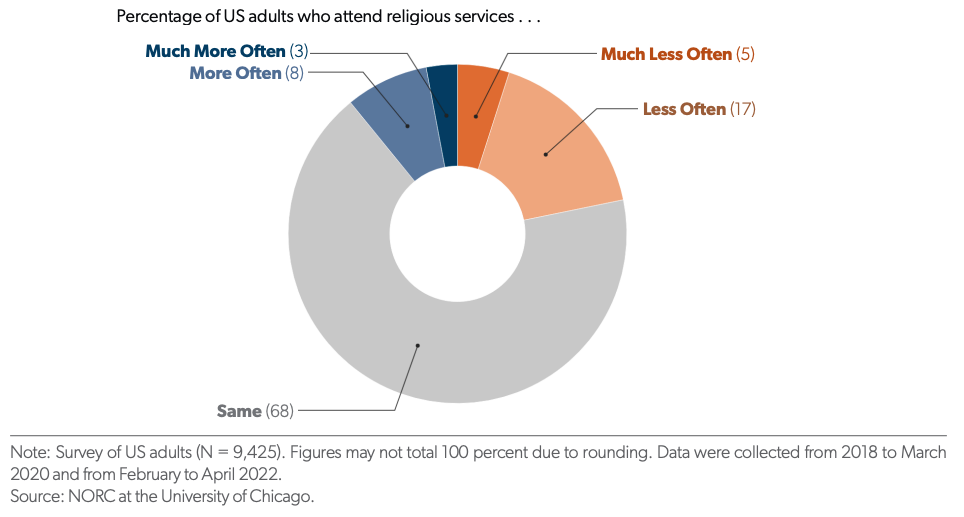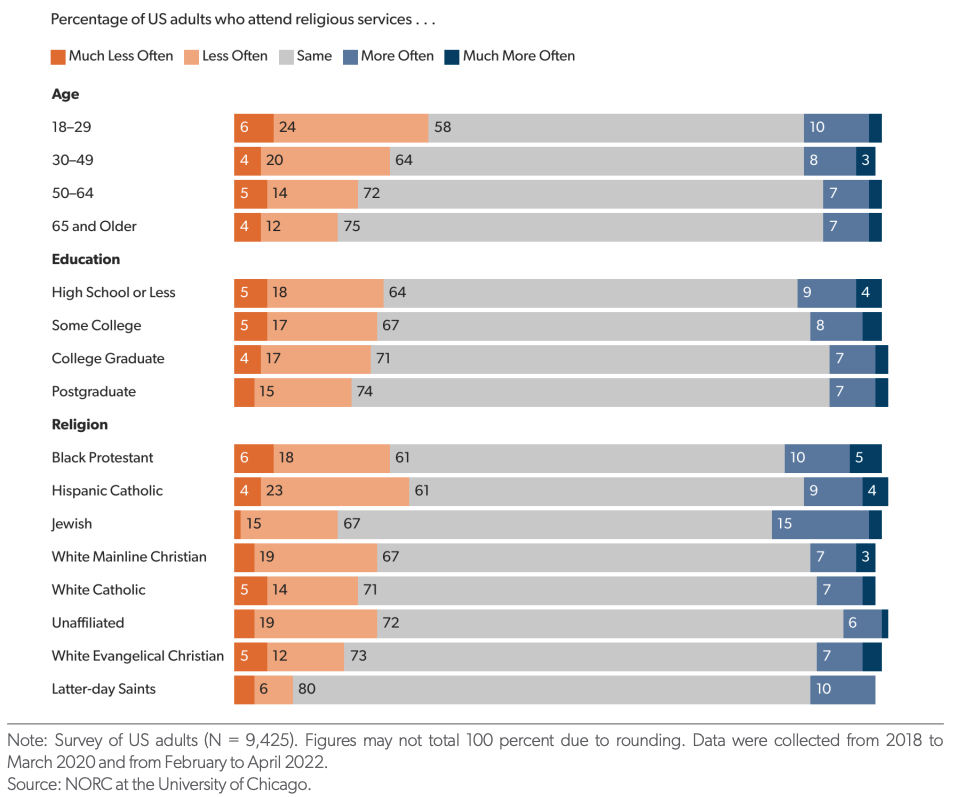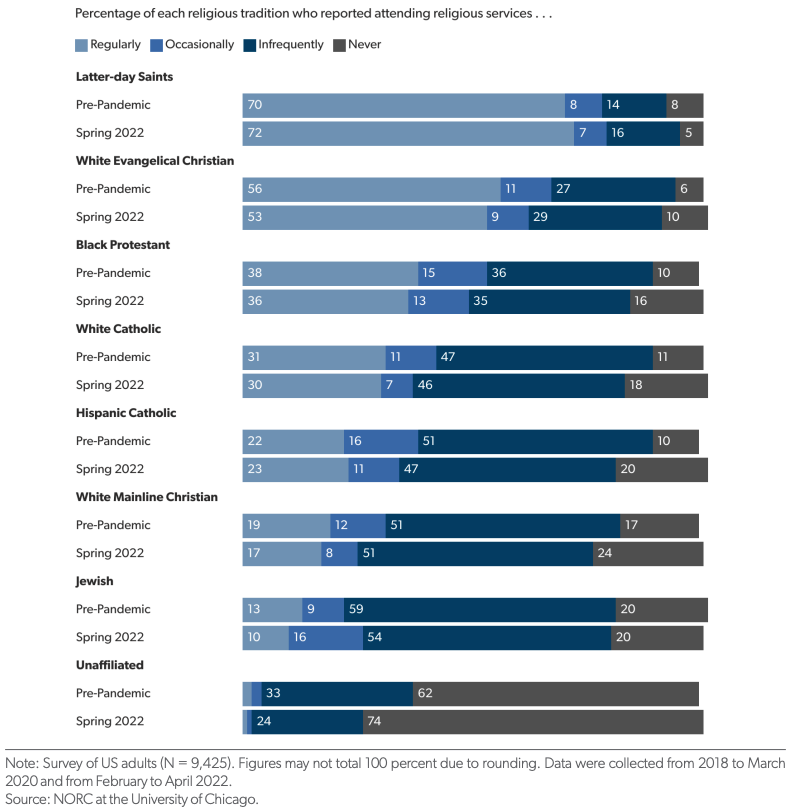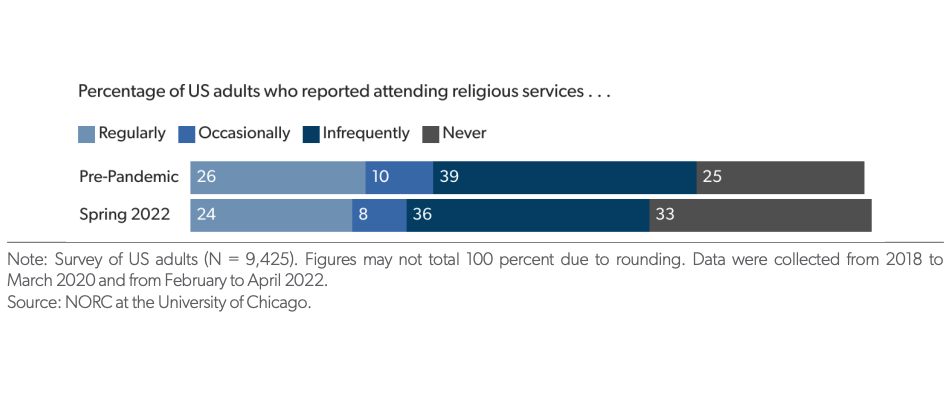The COVID-19 pandemic caused significant disruptions to American religious life by accelerating ongoing downward trends in religious attendance, with the biggest decreases occurring among young adults and those with previously infrequent levels of participation, new research shows.
The January survey by the Survey Center on American Life at AEI and the NORC research center at the University of Chicago tracked changes in religious identification and participation before and after the pandemic.
While changes were noted across most groups, researchers found that generation and sporadic pre-pandemic attendance patterns were among the most notable predictors of attendance declines by 2022.

“Young people, those who are single, and self-identified liberals ceased attending religious services at all at much higher rates than other Americans did. Even before the pandemic, these groups were experiencing the most dramatic declines in religious membership, practice and identity,” the report explains. “At least in terms of religious attendance, the pandemic appears to have pushed out those who had maintained the weakest commitments to regular attendance.”
The authors of the study said they also observed a “decoupling of identity and experience” in the data, meaning religious affiliation may no longer be a reliable indicator of American spiritual practice and theological conviction.
“Nearly every major religious tradition … has experienced a drop in worship attendance,” the report says. “This gap may also signal the rise of cultural religiosity — with identity linked to ethnic or cultural aspects of the tradition rather than specific religious beliefs or rituals.”
Age groups aside, religious attendance as a whole has taken a beating since the pandemic, with more Americans than ever reporting they never attend services or that they attend less regularly than in previous years, the survey found.
“Before the coronavirus pandemic, 75% of Americans reported attending religious services at least once a year, including about one-quarter (26%) who attended regularly (at least a few times a month). By spring 2022, roughly two-thirds of the public reported attending religious services at least once a year,” the report explains.

Demographic groups resisting that trend included married and older adults, and college-educated Americans, researchers said.
But most resistant to major changes in worship attendance were conservatives who “were more likely to attend religious services, and especially to do so regularly, than liberals and moderates were,” the report documents. “In spring 2022, 20% of conservatives never attended service. That was a 6-percentage-point increase from the 14% who never attended before the pandemic.”
By comparison, 31% of liberals reported never attending services pre-pandemic versus 46% who were no longer attending last year, the survey found. “Those changes result in a 26-percentage-point gap between liberals and conservatives attending at all.”
Another significant disparity was spotted between older and younger generations of Americans.
“The age gap in religious attendance widened during the pandemic,” the report states. “Pre-pandemic, three in 10 young adults and 20% of seniors (age 65 or older) said they never attended religious services, a 9-percentage-point gap. In spring 2022, more than four in 10 (43%) of young adults said they never attended services, compared to 23% of seniors. There was almost no change in the proportion of seniors who regularly or occasionally attend services.”

Shifts in patterns of religious attendance also varied by religious tradition from before the pandemic through the spring of 2022.
White evangelical Christians who never attend church ticked up from 6% to 10% during that period, followed by Black Protestants (10% to 16%), white Catholics (11% to 18%), Hispanic Catholics (10% to 20%) and white mainline Christians (17% to 24%).
Jewish Americans held steady at 20% during that span while Latter-day Saints experienced a decrease in those reporting they never attend, from 8% before the pandemic to 5% last spring.
“Despite the significant increase in Americans who never attend religious services, most Americans report attending at rates similar to before the pandemic,” the authors explain. “Most adults attended religious services pre-pandemic and in spring 2022 at the same frequency when looking at changes in religious attendance at the individual level.”
From that perspective, 68% of U.S. adults said they attended religious services at the same frequency in spring of 2022 as they did before the pandemic.
“However, the pandemic appears to have resulted in an overall depression of religious participation,” researchers said. “Among the remaining third, twice as many adults reported attending religious services less or much less often, compared to 11% of adults who reported an increase in attendance.”
For many Americans, what began as infrequent attendance before the pandemic often led to zero attendance a couple years later.
For many Americans, what began as infrequent attendance before the pandemic often led to zero attendance a couple years later.
“Nearly all Americans who have shifted to no longer attending religious services at all were those who infrequently attended before the pandemic. Few Americans who were regularly attending before the pandemic report that they no longer attend at all. And few of those who were occasionally attending services before the pandemic report that they do not attend anymore.”
And no group of Americans experienced more change in attendance patterns than young adults.
“More than four in 10 young adults report different levels of religious participation today than they did before the pandemic,” the report says. “Only 58% of young adults report the same level of religious attendance in spring 2022 as they did a couple years earlier. … In contrast, three-quarters of seniors are attending just as often today as they were before the pandemic. Sixteen percent of seniors are attending less often than they were before, and 9% are more involved.”
One area of relative stability identified in the report is religious affiliation nationwide.
“Nationally, religious identity among American adults has stayed largely consistent during the pandemic, with minimal evidence of religious switching during this period,” the report says. “The religious composition of the public in the years before the pandemic and after are nearly identical.”
But there was some movement detected at the individual level.
“Nineteen percent of individuals changed their religious affiliation between pre-pandemic and spring 2022, including 6% who were unaffiliated pre-pandemic but reported belonging to a religious tradition in spring 2022. A similar number (5%) identified with a religious tradition pre-pandemic but then were unaffiliated in spring 2022.”
Researchers suggested the study may predict an increase in religious polarization as the nation becomes increasingly populated by those who attend services actively, and those who do not attend at all.
“Very few Americans who were most active in their places of worship before the pandemic have since left,” the report notes. “However, those who were attending infrequently — attending just a few times a year — dropped at a much higher rate.”
Related articles:
‘Reverend, they ain’t ever coming back’: Confronting churchly realities 2022 | Opinion by Bill Leonard
Let’s stop the average Sunday attendance freak out | Opinion by Mark Tidsworth


